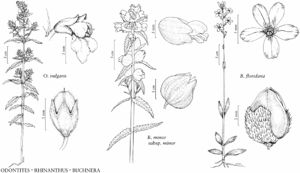Odontites
Inst. Regn. Veg. ed. 2, 120. 1757.
| Taxon | Illustrator ⠉ | |
|---|---|---|
 | Odontites vulgaris Rhinanthus minor subsp. minor Buchnera floridana | Yevonn Wilson-Ramsey Barbara Alongi Yevonn Wilson-Ramsey |
Herbs, annual; hemiparasitic. Stems erect, not fleshy, villous. Leaves cauline, opposite; petiole absent; blade not fleshy, not leathery, margins coarsely serrate. Inflorescences terminal, loose, unilateral racemes; bracts present. Pedicels present; bracteoles absent. Flowers: sepals 4, calyx moreorless symmetric, not flattened laterally, campanulate, not accrescent in fruit, lobes deltate, subequal; petals 5, corolla purple to pink, dorsally obcompressed, strongly bilabiate, tubular to funnelform, abaxial lobes 3, adaxial 2, adaxial lip galeate; stamens 4, slightly didynamous, filaments papillose proximally, with spiral hairs at apex and club-shaped hairs at connective, anther mucros equal; staminode 0; ovary 2-locular, placentation axile; stigma capitate. Capsules: dehiscence loculicidal. Seeds 20–32, white, fusiform, wings absent. x = 9, 10.
Distribution
Introduced; w Eurasia, n Africa
Discussion
Species 26 (1 in the flora).
Molecular phylogenetic analysis indicates a close relationship between Odontites and six other genera, of which Bartsia, Bellardia, and Euphrasia occur in the flora area (J. R. Bennett and S. Mathews 2006; J. Těšitel et al. 2010; S. Uribe-Convers and D. C. Tank 2016). Odontites has been subdivided into five genera, four of which consist of one or two geographically limited species (M. Bollinger 1996); Odontites in the broad sense, as treated here, is much more diverse and geographically widespread.